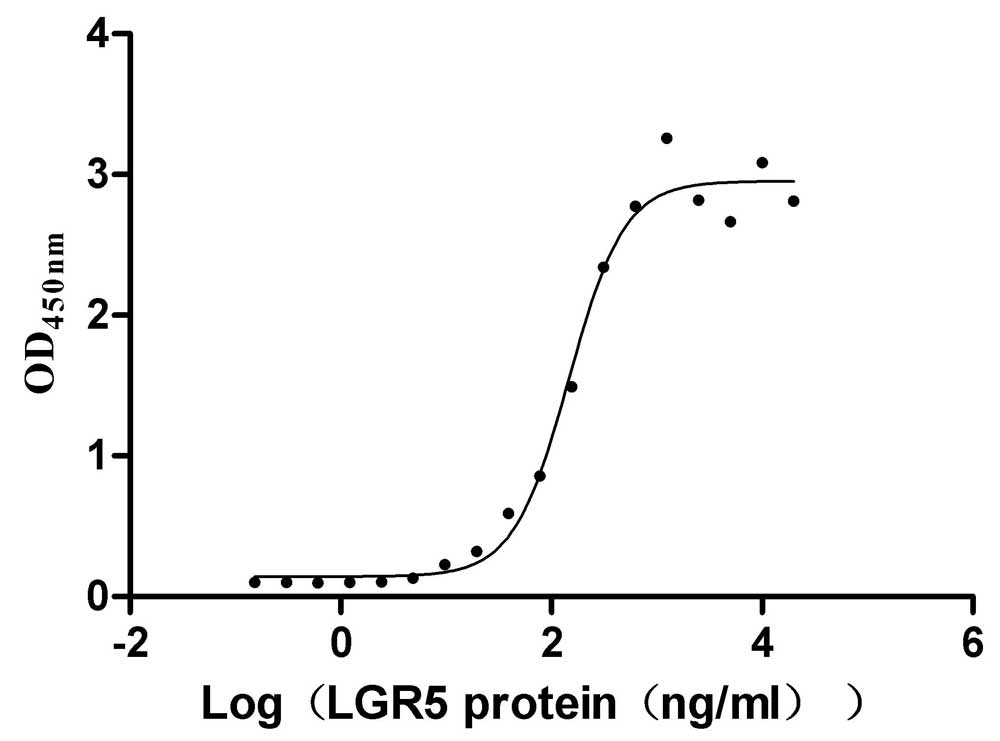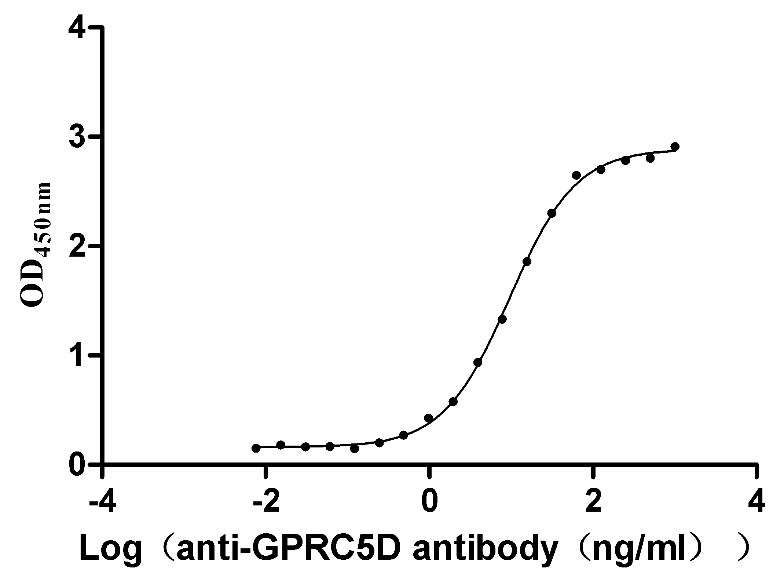Recombinant Rat Solute carrier family 22 member 5 (Slc22a5), partial
-
货号:CSB-YP021460RA
-
规格:
-
来源:Yeast
-
其他:
-
货号:CSB-EP021460RA
-
规格:
-
来源:E.coli
-
其他:
-
货号:CSB-EP021460RA-B
-
规格:
-
来源:E.coli
-
共轭:Avi-tag Biotinylated
E. coli biotin ligase (BirA) is highly specific in covalently attaching biotin to the 15 amino acid AviTag peptide. This recombinant protein was biotinylated in vivo by AviTag-BirA technology, which method is BriA catalyzes amide linkage between the biotin and the specific lysine of the AviTag.
-
其他:
-
货号:CSB-BP021460RA
-
规格:
-
来源:Baculovirus
-
其他:
-
货号:CSB-MP021460RA
-
规格:
-
来源:Mammalian cell
-
其他:
产品详情
-
纯度:>85% (SDS-PAGE)
-
基因名:Slc22a5
-
Uniprot No.:
-
别名:Slc22a5; Octn2; Solute carrier family 22 member 5; CT1; High-affinity sodium-dependent carnitine cotransporter; Organic cation/carnitine transporter 2; UST2r
-
种属:Rattus norvegicus (Rat)
-
蛋白长度:Partial
-
蛋白标签:Tag type will be determined during the manufacturing process.
The tag type will be determined during production process. If you have specified tag type, please tell us and we will develop the specified tag preferentially. -
产品提供形式:Lyophilized powder
Note: We will preferentially ship the format that we have in stock, however, if you have any special requirement for the format, please remark your requirement when placing the order, we will prepare according to your demand. -
复溶:We recommend that this vial be briefly centrifuged prior to opening to bring the contents to the bottom. Please reconstitute protein in deionized sterile water to a concentration of 0.1-1.0 mg/mL.We recommend to add 5-50% of glycerol (final concentration) and aliquot for long-term storage at -20℃/-80℃. Our default final concentration of glycerol is 50%. Customers could use it as reference.
-
储存条件:Store at -20°C/-80°C upon receipt, aliquoting is necessary for mutiple use. Avoid repeated freeze-thaw cycles.
-
保质期:The shelf life is related to many factors, storage state, buffer ingredients, storage temperature and the stability of the protein itself.
Generally, the shelf life of liquid form is 6 months at -20°C/-80°C. The shelf life of lyophilized form is 12 months at -20°C/-80°C. -
货期:Delivery time may differ from different purchasing way or location, please kindly consult your local distributors for specific delivery time.Note: All of our proteins are default shipped with normal blue ice packs, if you request to ship with dry ice, please communicate with us in advance and extra fees will be charged.
-
注意事项:Repeated freezing and thawing is not recommended. Store working aliquots at 4°C for up to one week.
-
Datasheet :Please contact us to get it.
靶点详情
-
功能:Sodium-ion dependent, high affinity carnitine transporter. Involved in the active cellular uptake of carnitine. Transports one sodium ion with one molecule of carnitine. Also transports organic cations such as tetraethylammonium (TEA) without the involvement of sodium. Also relative uptake activity ratio of carnitine to TEA is 11.3.
-
基因功能参考文献:
- OCTN2 plays a positive role in epididymal epithelial cells, and might be useful in the clinical treatment of male infertility by serving as a key regulatory factor. PMID: 28666211
- HgCl2 and methylmercury inhibit OCTN2 carnitine transporter in the proteoliposome experimental model. PMID: 22900493
- The present study showed that muscle contraction facilitated carnitine uptake in skeletal muscles, possibly via the contraction-induced translocation of its specific transporter OCTN2 to the plasma membrane. PMID: 22310714
- Data suggests that Slc22a5 plays a role in kidney in reabsorption of carnitine from urine; with training in physical activity, expression of Slc22a5 mRNA is up-regulated in kidney. PMID: 22014179
- Lipopolysaccharide-induced inflammation generally downregulates glucose, fatty acid, and L-carnitine transporter expression; whether this leads to reductions in substrate availability to epithelial cells requires investigation. PMID: 20381822
- OCTN2 is functionally expressed in skeletal muscles and is involved in the import of carnitine for fatty acid oxidation, especially in highly oxidative muscles. PMID: 20219053
- Present study demonstrates expression of octn2 and octn3 genes coding high affinity carnitine transporters, as well as presence of both proteins in neurons obtained from suckling and adult rats. PMID: 20143157
- This is the first report showing a functional apical OCTN2 in the renal medulla and a functional apical OCTN3 in both renal cortex and medulla. PMID: 20112288
- OCTN2 is involved in the transport of acetyl-L-carnitine from the circulating blood to the retina across the inner BRB. PMID: 19684012
- The role of carnitine in inflammatory bowel disease (IBD)was evaluated using the expression of the carnitine transporters OCTN2 and ATB0+, and butyrate metabolism in colonocytes in a rat model of IBD. PMID: 17065219
- Clofibrate upregulates OCTN2 in the liver and small intestine, suggesting that an increased intestinal absorption of carnitine might also contribute to the clofibrate-induced increase in hepatic carnitine concentration. PMID: 17644405
- OCTN2 localization at the basolateral membrane and in the cytoplasmic region in the vicinity of nuclei. Localization of OCTN2 suggest that carnitine can be also transported from the brain, playing an important role in removal of certain acyl esters. PMID: 17995936
- Cell system suitable for studying in vitro interactions with OCTN2. PMID: 18408886
- the nuclear receptor PPARalpha directly up-regulates the expression of Octn2 and increases the hepatic uptake of carnitine via Octn2 PMID: 18520060
- Role of Na+/L-carnitine transporter (OCTN2) in renal handling of pivaloylcarnitine and valproylcarnitine formed during pivalic acid-containing prodrugs and valproic acid treatment. PMID: 18762717
- Northern and RT-PCR assays revealed that maturation increased renal expression of OCTN2 mRNA PMID: 19150623
显示更多
收起更多
-
亚细胞定位:Membrane; Multi-pass membrane protein.
-
蛋白家族:Major facilitator (TC 2.A.1) superfamily, Organic cation transporter (TC 2.A.1.19) family
-
组织特异性:Expressed in the proximal and distal tubules and in the glomeruli in the kidney, in the myocardium, valves, and arterioles in the heart, in the labyrinthine layer of the placenta, and in the cortex, hippocampus, and cerebellum in the brain.
-
数据库链接:
KEGG: rno:29726
STRING: 10116.ENSRNOP00000011340
UniGene: Rn.8844
Most popular with customers
-
Recombinant Human CD226 antigen (CD226), partial (Active)
Express system: Mammalian cell
Species: Homo sapiens (Human)
-
Recombinant Human B-lymphocyte antigen CD20 (MS4A1)-VLPs (Active)
Express system: Mammalian cell
Species: Homo sapiens (Human)
-
Recombinant Human R-spondin-1 (RSPO1), partial (Active)
Express system: Mammalian cell
Species: Homo sapiens (Human)
-
Recombinant Human G-protein coupled receptor family C group 5 member D (GPRC5D)-VLPs (Active)
Express system: Mammalian cell
Species: Homo sapiens (Human)
-
Recombinant Dog Angiopoietin-2 (ANGPT2) (Active)
Express system: Mammalian cell
Species: Canis lupus familiaris (Dog) (Canis familiaris)
-
Express system: Mammalian cell
Species: Homo sapiens (Human)
-
Recombinant Human Claudin-6 (CLDN6)-VLPs (Active)
Express system: Mammalian cell
Species: Homo sapiens (Human)
-
Recombinant Human Microtubule-associated protein tau (MAPT) (Active)
Express system: Mammalian cell
Species: Homo sapiens (Human)








-AC1.jpg)
-AC1.jpg)










